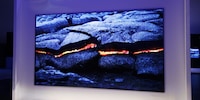
Background information
MicroLED vs. OLED: Which one’s going to prevail?
by Luca Fontana

At a semi-secret press conference ahead of CES 2019 in Las Vegas, Samsung announced that it will support Apple TV and iTunes on its televisions. Plus: Micro LED is set to make its way into the home.
Rumours are swirling around Samsung in the run-up to the CES in Las Vegas. The foldable smartphone is rumoured to be coming. Or the Samsung Galaxy S10. A semi-secret press conference the day before the official media day is set to offer the first insights into the work of the South Korean technology company. Somewhere in the bowels of the Aria Hotel and Resort - one of those gigantic buildings that guests never actually need to leave once they are inside - Samsung has invited guests. On the guest list: Stephanie Tresch and Dominik Bärlocher, Medium: digitec.ch. And around 1000 other journalists from all over the world. Because the invite-only event is only half-secret.
Screen technologies are shown instead of smartphones
Five minutes before the event begins, the journalists put their mobiles aside and gather in front of the stage. Then Jonghee Han, President of the Visual Display Business at Samsung, takes the stage.
Han starts the press conference with questions. What is the next revolution in the screen business? What comes after the touch screen? How can TVs embed themselves in a modern, interactive life? Of course, the raspy-voiced man with a gentle but firm voice has answers.

He doesn't beat about the bush. He is convinced that Samsung televisions deliver the best picture quality currently on the market. With a grin, he talks about The Wall, the 146-inch television monster that caused a stir last year with micro LED panels. Now the thing is getting a massive upgrade.
The micro LED panels now come with a screen diagonal of up to 75 inches. The journalists applaud, even though there is only one TV on the stage. After all, the picture quality is impressive, even in the dim light and blue spotlights of the Aria meeting room, which would easily pass for a gymnasium in Switzerland.

Why is this so spectacular? It's only a 75-incher, you think? The micro-LED screens can be combined. The technology breaks with the usual form factor of the TV or display technology, because a micro LED TV consists of freely combinable panels that negotiate the image among themselves. Naturally, the resolution can be increased as required. Up to 10K should be possible with The Wall. Even if the footage you want to play on the screen was not filmed at 10K - after all, what is filmed at 10K? - the same AI upscaling that is already built into the 8K TV is at play here.
Han has spoken for ten minutes and says goodbye. That's nice. We really appreciate such short press conferences. His colleague Andrew Savoy, Vice President of Visuals at Samsung US, takes the stage.
Where The Wall was previously only of interest to business customers, Samsung wants to bring Micro LED technology to the home cinema. Not only are the panels borderless, but according to the man on stage, they last longer than any other technology on the market.
With the variable form factor and everything else, the TV is set to take on a new status in the household. From spring 2019, televisions from the South Korean manufacturer, which relies on its own Android distro Tizen, will support Apple TV and Airplay as well as iTunes.
"The New Bixby" will be embedded in this system. Bixby is Samsung's voice assistant, which is still quite useless in Switzerland as it is not localised enough and only available in English, but is becoming increasingly interesting with these integrations.
Savoy is also finished after ten minutes. The curtain falls behind him, the hands-on area is open.
All articles on CES 2019 can be found here.
Journalist. Author. Hacker. A storyteller searching for boundaries, secrets and taboos – putting the world to paper. Not because I can but because I can’t not.